Comparing fermentation techniques in Petit Manseng (2018)
Emily Pelton
Veritas Vineyards and Winery
Summary
Virginia has the second largest acreage of Petit Manseng in the world2. It is a good fit for Virginia due to its loose clusters, thick skins, and resistance to bunch rots1. This variety exhibits high acidity even at harvest, along with rapid accumulation of sugar. The aim of this study was to explore skin fermentation as a means to achieve balance in a dry style Petit Manseng. The same lot of grapes was processed three ways: overnight skin contact with pressing prior to fermentation, fermentation on skins in a Tbin, and fermentation on skins in a cocciopesto amphora. Fermentation on skins in both vessels was faster and hotter than the tank fermentation of pressed juice. Skin fermented wine had notably lower alcohol than tank fermented wine. Tbin and cocciopesto wines finished fermentation with notably higher pH and A420 (browning). These wines had lower malic acid and higher lactic acid, indicating the activity of malic acid bacteria. Skin fermented wines also exhibited higher levels of volatile acidity and phenolics. Blind sensory analysis by wine producers indicated a preference for the tank fermented wine, with significantly higher scores for balance and varietal character in the tank wine. The skin fermented wines had significantly higher scores for bitterness and astringency. Skin fermentation, either in Tbin or cocciopesto amphora shifts the balance of pH much higher and reduces alcohol, however, these wines also have unpleasant levels of volatile acidity, bitterness and astringency.
Introduction
Petit Manseng originates from the Jurançon region of Southwest France, where it is predominantly made in sweet and off-dry styles, often in blends with Gros Manseng and other varieties1. The second largest acreage of Petit Manseng in the world is in Virginia2, where it is favored for its loose clusters, thick skins, and resistance to bunch rots1. This variety exhibits high acidity even at harvest, along with rapid accumulation of sugar. This chemical profile lends itself easily to desert style wines, however, many winemakers are seeking to make this wine in a style that is less sweet. The balance of acidity and alcohol from high Brix grapes leads to challenges in fermenting Petit Manseng to dryness, however this chemistry is seen has having potential to produce a full bodied, ageable dry white wine.
One approach for balancing the acidity of Petit Manseng has several hours of pre-fermentation skin contact of crushed and destemmed grapes.. The pH of the juice decreases as potassium from the skins complexes with tartaric acid to precipitate out of solution. Some phenolic extraction is also likely during this maceration. The juice fermented in tank in this experiment was subject to overnight skin contact prior to pressing.
Fermentation on white grape skins is traditional in regions such as Georgia, where white grapes are fermented in Quevri, a form of amphora. These vessels are buried in the ground to moderate temperature, and the resulting wines are amber in color3. Diaz et al (2013) surveyed 15 European wine varieties made in both conventional and qvevri styles and compared the resulting chemistry. Qvevri wines had much higher pH, with ranges of 3.6-4.3 and a mean of 3.8 compared with 3.0-3.4 in conventionally made wines. Qvevri wines also had much lower tartaric acid (0-2.6 g/L) compared with 2.3-3.5 g/L in conventionally made wines. Many of these wines had undergone malolactic fermentation, as evidenced by very low levels of malic acid and higher levels of lactic acid. Qvevri wines also had higher phenolic content, presumably due to skin contact and high acetic acid (0.8 g/L on average). High acetic acid is attributed to longer maceration times as well as oxidative conditions during juice handling3.
The aim of this study was to explore the effects of skin fermentation on the style of dry Petit Manseng and to honor the tradition of amphora style winemaking. Three fermentation techniques were utilized: overnight skin contact prior to pressing then fermentation, skin fermentation in T Bin, skin fermentation in cocciopesto amphora.
Methods
Grapes were harvested on September 20 and refrigerated overnight. Grapes were destemmed and crushed the next day with the addition of 40 ppm SO2. Three treatments were pursued:
- Tank: One third of the grapes were crushed to TBins, held overnight in a refrigerated trailer, then pressed to tank the following day. Juice was cold settled overnight then racked to a temperature controlled tank for fermentation. Fermentation was monitored daily. After completion of fermentation, 45ppm SO2 was added and wine was racked to neutral barrels for storage.
- Tbin: One third of the grapes were crushed to TBin then inoculated and allowed to ferment on skins in the TBin with one gentle punchdown per day. After completion of fermentation the TBin was gassed and sealed to prevent oxidation until pressing. The TBin was drained on December 6. Only free run juice was used for the experiment. After draining, 1 g/L tartaric acid and 45 ppm SO2 were added.
- Cocciopesto: One third of grapes were crushed to a cocciopesto amphora, inoculated and allowed to ferment on skins in the amphora. At the end of fermentation, the amphora was gassed and sealed until pressing on December 6. Only free run juice was used for this experiment. After draining, 1 g/L tartaric acid and 45 ppm SO2 were added.
Each treatment was inoculated with 25 g/hL ICV D47 (Scottlabs, Lallemand) rehydrated in 6 g/hL Fermoplus Energy Glu (AEB) and received 30 g/hL Actimax Naturae nutrient (Agrovin) at ⅓ brix depletion.
Sensory analysis was completed by a panel of 29 wine producers. Wines were presented blind in randomly numbered glasses. Tasters were presented with three wines, one of each fermentation treatment, and asked to rank the wine by preference with 1=most preferred and 3=least preferred. There were three tasting groups with three different tasting orders for these wines. Tasters were then asked to score each wine on a scale of 0 to 10 for the perception of acidity, bitterness, astringency, Petit Manseng varietal character, and overall balance. They were also given open ended questions to describe the wines. Preference test was evaluated using a Friedman’s Test. Descriptive scores were analyzed using repeated measures ANOVA.
Results
Juice chemistry for each fermentation vessel can be found in Table 1. Malic acid was measured on the pressed juice only. There was 4.92 g/L malic acid at the beginning of fermentation. The pH and TA of these vessels differed slightly, however these differences could be due to the fact that the juice in the tank fermentation had already undergone a pressing operation while the other 2 tanks had not yet been pressed, meaning these differences are inherent to the protocol being tested rather than differences in original fruit.

Fermentation curves for the three treatments can be found in Figure 1. Fermentation proceeded more quickly in TBin and cocciopesto, finishing on October 3, when compared to tank, which finished on October 16. The TBin fermentation saw the highest fermentation temperature of 73.7°F. Maximum temperature in the cocciopesto was 69.4°F while the tank temperature was 63.7°F.
Finished wine chemistry for the three wines can be found in Table 2. Skin contact wines had higher pH after fermentation than tank fermentaiton. After pressing, TBin and cocciopesto wines received 1 g/L tartaric acid while wine fermented in tank did not need this addition. Skin fermented wines also had lower malic acid and higher lactic acid as well as higher acetic acid. Each of these trends is consistent with the results found by Diaz et al (2013). The skin fermented wines also had a full degree lower alcohol than the tank fermentd wine. This may be in part due to the effect of higher temperature in the fermentations that occurred in the present of skins.
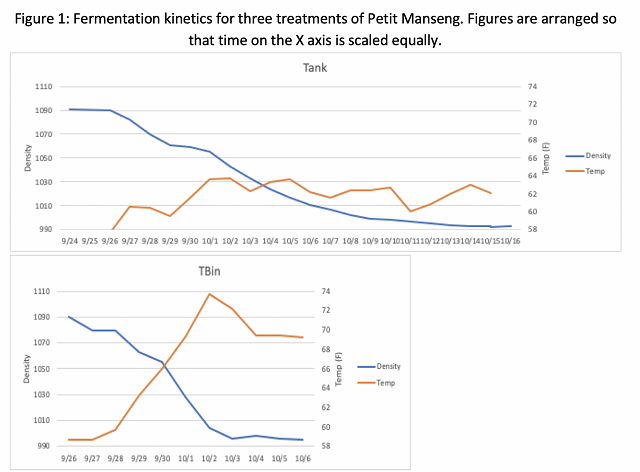
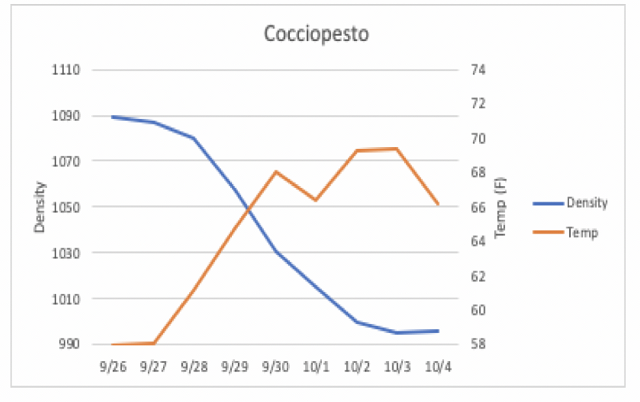
Absorbance at 420 nm is a measure of browning in white wines. Wines fermented on skins had higher levels of browning, which was also visually apparent. This is likely due to higher amounts of phenolic extraction as well as oxidative conditions during fermentation and extended maceration. White wine phenolics (Table 3) show higher level of pulp phenolics (caftaric acid, Grape Reactive Product ) in the tank fermented juice while seed phenolics were much higher in the skin contacted wines. These levels are still below threshold for bitterness. For example, the threshold for bitterness from catechin is 200 mg/L and quercetin glycosides is 30 mg/L. Tannins are also elevated in the skin fermented wines. White wines have an average of 10 mg/L tannin while red wines have an average of 750 mg/L. These wines are in between these values.
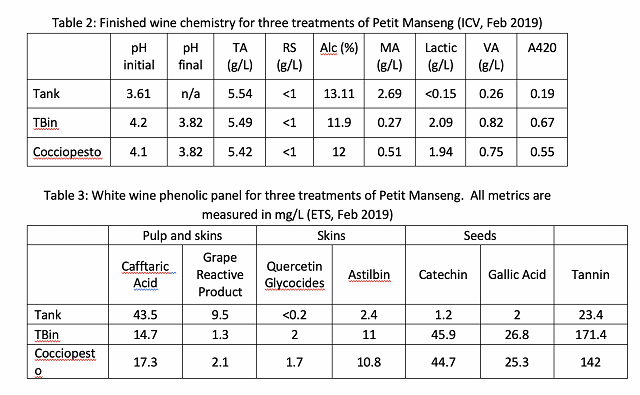
When 29 wine producers were presented with these wines and asked to rank them in order of preference, with 1 indicating most preferred and 3 indicating least preferred, the wine fermented in tank was significantly preferred over the Tbin and cocciopesto wines (Q = 13.66, P= 0.001) (Figure 2). The there was no significant difference in preference between the TBin fermented wine and the wine fermented in the cocciopesto.
When asked to score these wines for specific descriptors, wine producers gave the Tbin and cocciopesto wines higher scores for bitterness and astringency and lower scores for Petit Manseng character and overall balance relative to tank fermented wines (Figure 3, Table 4). There were no significant differences in perception of acidity among the wines. In group discussion following sensory analysis, winemakers remarked that, in their experience, skin contact white wines needed time to age in order to soften the astringency and bitterness common with this technique. However, with higher levels of volatile acidity and higher pH, longer aging time includes risk.
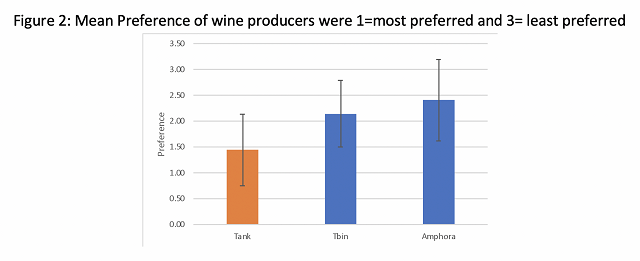
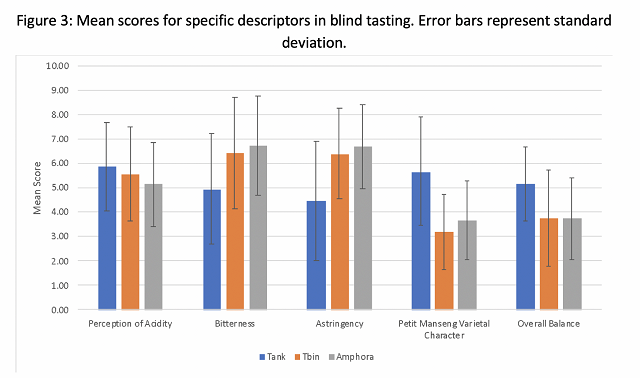
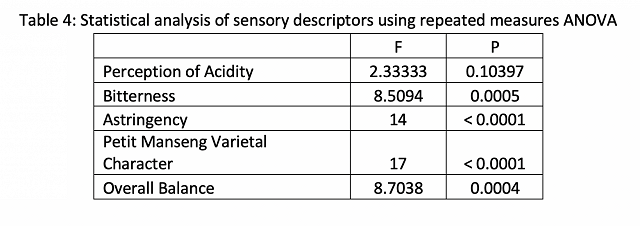
Conclusions
Skin fermentation of white wines is a traditional approach in some Eastern European wine growing regions. Skin fermentation was employed here to determine if this approach would be a desirable style for dry Petit Manseng. The appeal of this approach would be the expected moderation of acidity and alcohol. However, skin fermentation also led to unpleasantly high levels of volatile acidity, astringency and bitterness along with loss of aromas and flavors associated with Petit Manseng varietal character. It is possible that longer aging time will moderate the sensory effects of phenolics, reducing bitterness and astringency, however volatile acidity is likely to continue to rise with longer aging.
References
(1) Wolf, T. K. Wine Grape Production Guide for Eastern North America; Plant and Life Sciences Publishing: Ithaca, New York, 2008.
(2) Wood, V.; Custer, S.; Watson, K.; Alper, D. Virginia 2018 Commercial Grape Report. 11.
(3) Díaz, C.; Laurie, V. F.; Molina, A. M.; Bücking, M.; Fischer, R. Characterization of Selected Organic and Mineral Components of Qvevri Wines. Am J Enol Vitic. 2013, 64 (4), 532–537. https://doi.org/10.5344/ajev.2013.13027.
